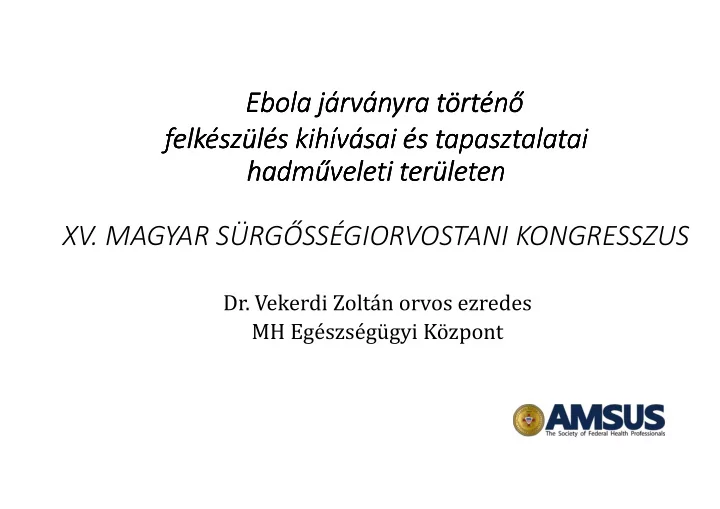

Ebola járványra történő Ebola járványra történő Ebola járványra történő Ebola járványra történő felkészülés kihívásai és tapasztalatai felkészülés kihívásai és tapasztalatai felkészülés kihívásai és tapasztalatai felkészülés kihívásai és tapasztalatai hadműveleti területen hadműveleti területen hadműveleti területen hadműveleti területen XV. MAGYAR SÜRGŐSSÉGIORVOSTANI KONGRESSZUS Dr. Vekerdi Zoltán orvos ezredes MH Egészségügyi Központ
Learning Objectives: At the conclusion of this activity, the participant will be able to: 1. Learn about best promising practices in risk assessment and risk management 2. Understand the challenges casued by differences in risk acceptance by troop contributing nations 3. Outline possible courses of action for similar challenges
Risk of EVD for EUFOR personnel • Low – No direct contact with EVD patients – No confirmed, suspected or possible case in CAR
Phases of Response Phase Features Measures 0 No EVD in CAR - Information gathering - Planning - Coordination 1 Confirmed EVD in CAR - Procurement, preparation - Coordination 2 Confirmed EVD in Bangui - Raising awareness among soldiers - Infection prevention measures 3 Confirmed EVD in ECOLOG - Requesting assistance (RDOIT*) 4 Confirmed EVD in EUFOR - Infection control measures *RDOIT – Rapid Deployable Outbreak Investigation Team
Risk Management, General Concept Prevent Epidemics to happen (educate, train, build stockpiles and prepare) Detect Suspected and possible cases (screen health status of people entering UCATEX) Respond Fast and effectively to the disease (to prevent spreading and save the patients)
Elements of Successful Management • Fast detection - Vigilance (medical intelligence) - Awareness (medical personnel, both EUFOR and ECOLOG) - Laboratory background (Institute Pasteur Bangui) • Fast reaction - Medical personnel - Material (personal protective equipment, consumables) - Infrastructure (isolator) - Strategy (quarantine, isolation, care, treatment, evacuation) - Security
Institute Pasteur Bangui
History • Established in 1961 • Part of a network of 32 Institutes • Budget – France (ministry of Health) – Donations
Medical personnel • 9 physicians – All graduated in France – All PhD degree – Numerous scientific publications
Capabilities Bio Safety Level 2 and 3 laboratory � Survey and reference laboratory � – For RCA – Regionally
Ebola Virus Disease detection • Double technique – PCR method – Genetic material detection • Results (as of Aug 19, 2014) – Five suspected samples – All proved to be negative
Real PCR - US CDC donation - ≈ 15 000 USD
Quality Assurance • Internal audit – Procedures – Training and selection of medical personnel • Education and training of local students • External audit – Through the network of institutes
• Cooperation framework outlined – Exchange of information – Notification about viral emergency cases • If a confirmed EVD in RCA or Bangui appears – Laboratory support • Point of Contact – Emmanuel NAKOUNE, PhD Director of IPB enakouney@gmail.com
Cooperation and Coordination • Local SANGARIS Mission • ECOLOG • NGOs • Ministry of Health • Institute Pasteur Bangui • Regional EUTM- Mali • WHO Regional Office • Global EUFOR RCA HQ Larissa, Greece; EU HQ Brussels; TCNs • WHO
Window of Opportunity Open until the first EVD case appears in Bangui - planning - coordinating - procuring - preparing
Task Force Responsibility • Use the window of opportunity effectively - monitor & assess the situation - explore and prioritize tasks - develop possible courses of action & advise the Cdr
• Isolation of sick - Isolator (select location, build and equip) • Until STRATEVAC, recovery, or death • Treatment • Personnel, equipment, material • Quarantine of the contacts - Select location, build, equip - Security (guard) - Real life support
Nr. Phase Characteristics 0 No confirmed EVD in RCA Impact No impact on mission accomplishment. EUFOR is a stabilizing factor in the area of operation. Major issues Planning Medical Intelligence Cooperation Awareness Procurement Nr. Phase Characteristics Mission accomplishment is severely hampered, Confirmed EVD among EUFOR 4 Impact or impossible. personnel EUFOR becomes part of the problem, and requires robust external support. Strategic issues Can the mission be continued? Are EVD patients to be evacuated, or treated on the spot? Messages to be delivered to target populations.
Courses of Action • Patient management Treatment or Evacuation • Treatment options In the theatre or out of it • Impact on mission Adaptation options
• TCNs policy requirements and capabilities? – STRATEVAC or Stay-and-Play • Capacities and readiness Augmentation • • Medical resupply
STRATEVAC of the EVD case out of the theater • Probability: Medium to High • Advantages: both for the patient and us • Disadvantages: N/A • Precondition: decision, appropriate & available STRATEVAC
Evacuation for treatment to Role-2 • Probability: Low • Advantages: both for the patient and us • Disadvantages: Role-2 blocked • Precondition: SANGARIS agreement
Augmentation of EUFOR medical staff by SANGARIS or TCNs • Probability: Medium • Advantages: both for the patient and us • Disadvantages: weakening of Role-2 • Precondition: available intensive care personnel
Evacuation of EVD cases for treatment to a local hospital • Probability: Low • Advantages: questionable • Disadvantages: low level treatment • Precondition: appropriate & available hospital
Barrier nursing of the EVD patient in UCATEX compound • Probability: Medium • Advantages: Forced compromise • Disadvantages: Negative treatment outcome • Forcing condition: no augmentation available
Closing the mission before Phase 3 • Probability: ? • Advantages: no risk • Disadvantages: psychological effect & possible political consequences • Precondition: in time political decision & available transport capacities
Lessons • Differences in Risk Acceptance by TCNs prevents common approach to risk management. • Risk management requires engagement of the command staff (Ebola Task Force). • Information, planning, education, cooperation, training, logistics – key elements of risk management.
Questions Thank you! COL Dr Zoltan VEKERDI Medical Advisor, EUFOR RCA
Recommend
More recommend